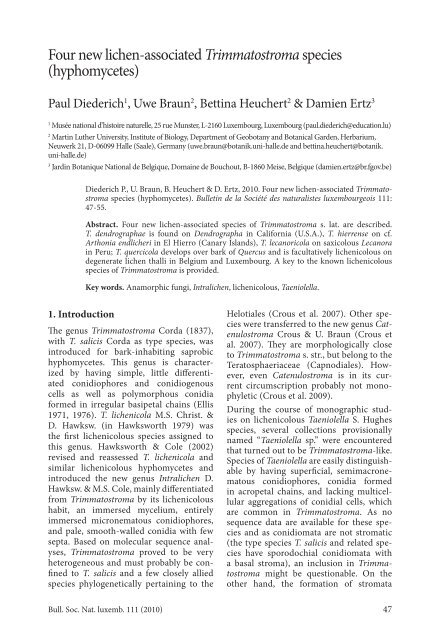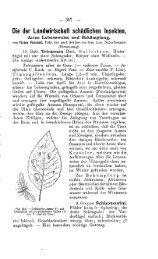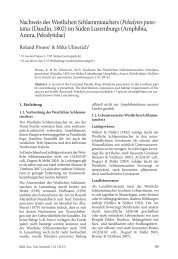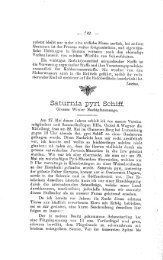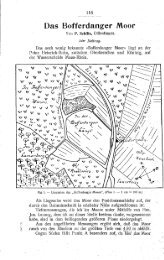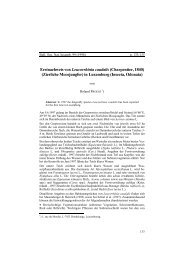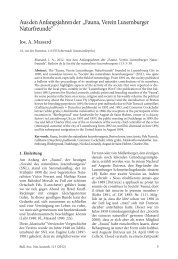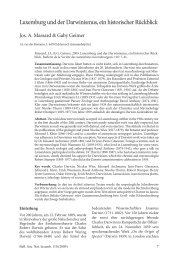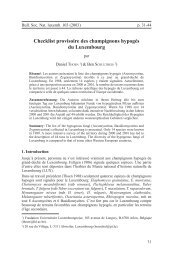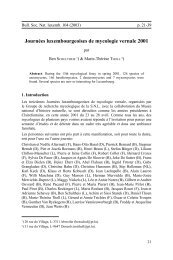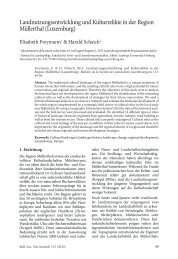Four new lichen-associated Trimmatostromaspecies ... - SNL
Four new lichen-associated Trimmatostromaspecies ... - SNL
Four new lichen-associated Trimmatostromaspecies ... - SNL
Create successful ePaper yourself
Turn your PDF publications into a flip-book with our unique Google optimized e-Paper software.
<strong>Four</strong> <strong>new</strong> <strong>lichen</strong>-<strong>associated</strong> Trimmatostroma species<br />
(hyphomycetes)<br />
Paul Diederich 1 , Uwe Braun 2 , Bettina Heuchert 2 & Damien Ertz 3<br />
1<br />
Musée national d’histoire naturelle, 25 rue Munster, L-2160 Luxembourg, Luxembourg (paul.diederich@education.lu)<br />
2<br />
Martin Luther University, Institute of Biology, Department of Geobotany and Botanical Garden, Herbarium,<br />
Neuwerk 21, D-06099 Halle (Saale), Germany (uwe.braun@botanik.uni-halle.de and bettina.heuchert@botanik.<br />
uni-halle.de)<br />
3<br />
Jardin Botanique National de Belgique, Domaine de Bouchout, B-1860 Meise, Belgique (damien.ertz@br.fgov.be)<br />
Diederich P., U. Braun, B. Heuchert & D. Ertz, 2010. <strong>Four</strong> <strong>new</strong> <strong>lichen</strong>-<strong>associated</strong> Trimmatostroma<br />
species (hyphomycetes). Bulletin de la Société des naturalistes luxembourgeois 111:<br />
47-55.<br />
Abstract. <strong>Four</strong> <strong>new</strong> <strong>lichen</strong>-<strong>associated</strong> species of Trimmatostroma s. lat. are described.<br />
T. dendrographae is found on Dendrographa in California (U.S.A.), T. hierrense on cf.<br />
Arthonia endlicheri in El Hierro (Canary Islands), T. lecanoricola on saxicolous Lecanora<br />
in Peru; T. quercicola develops over bark of Quercus and is facultatively <strong>lichen</strong>icolous on<br />
degenerate <strong>lichen</strong> thalli in Belgium and Luxembourg. A key to the known <strong>lichen</strong>icolous<br />
species of Trimmatostroma is provided.<br />
Key words. Anamorphic fungi, Intra<strong>lichen</strong>, <strong>lichen</strong>icolous, Taeniolella.<br />
1. Introduction<br />
The genus Trimmatostroma Corda (1837),<br />
with T. salicis Corda as type species, was<br />
introduced for bark-inhabiting saprobic<br />
hyphomycetes. This genus is characterized<br />
by having simple, little differentiated<br />
conidiophores and conidiogenous<br />
cells as well as polymorphous conidia<br />
formed in irregular basipetal chains (Ellis<br />
1971, 1976). T. <strong>lichen</strong>icola M.S. Christ. &<br />
D. Hawksw. (in Hawksworth 1979) was<br />
the first <strong>lichen</strong>icolous species assigned to<br />
this genus. Hawksworth & Cole (2002)<br />
revised and reassessed T. <strong>lichen</strong>icola and<br />
similar <strong>lichen</strong>icolous hyphomycetes and<br />
introduced the <strong>new</strong> genus Intra<strong>lichen</strong> D.<br />
Hawksw. & M.S. Cole, mainly differentiated<br />
from Trimmatostroma by its <strong>lichen</strong>icolous<br />
habit, an immersed mycelium, entirely<br />
immersed micronematous conidiophores,<br />
and pale, smooth-walled conidia with few<br />
septa. Based on molecular sequence analyses,<br />
Trimmatostroma proved to be very<br />
heterogeneous and must probably be confined<br />
to T. salicis and a few closely allied<br />
species phylogenetically pertaining to the<br />
Helotiales (Crous et al. 2007). Other species<br />
were transferred to the <strong>new</strong> genus Catenulostroma<br />
Crous & U. Braun (Crous et<br />
al. 2007). They are morphologically close<br />
to Trimmatostroma s. str., but belong to the<br />
Teratosphaeriaceae (Capnodiales). However,<br />
even Catenulostroma is in its current<br />
circumscription probably not monophyletic<br />
(Crous et al. 2009).<br />
During the course of monographic studies<br />
on <strong>lichen</strong>icolous Taeniolella S. Hughes<br />
species, several collections provisionally<br />
named “Taeniolella sp.” were encountered<br />
that turned out to be Trimmatostroma-like.<br />
Species of Taeniolella are easily distinguishable<br />
by having superficial, semimacronematous<br />
conidiophores, conidia formed<br />
in acropetal chains, and lacking multicellular<br />
aggregations of conidial cells, which<br />
are common in Trimmatostroma. As no<br />
sequence data are available for these species<br />
and as conidiomata are not stromatic<br />
(the type species T. salicis and related species<br />
have sporodochial conidiomata with<br />
a basal stroma), an inclusion in Trimmatostroma<br />
might be questionable. On the<br />
other hand, the formation of stromata<br />
Bull. Soc. Nat. luxemb. 111 (2010) 47
and conidiophores in sporodochia is often<br />
unreliable as distinctive generic character<br />
in hyphomycete genera. However, no<br />
other suitable genus is available. Therefore,<br />
we prefer to include the <strong>new</strong> <strong>lichen</strong>icolous<br />
taxa tentatively in Trimmatostroma<br />
s. lat. The final generic position of <strong>lichen</strong>icolous<br />
Trimmatostroma-like hyphomycetes<br />
depends on the phylogenetic affinity of the<br />
taxa concerned.<br />
Fig. 1. Trimmatostroma dendrographae. A–C, Infected thalli of Dendrographa. D, Conidiophore with chains of<br />
conidia, in water. E, Same, in KOH. F–J, Chains of conidia, in water. K, Conidiophore, in water. A: California,<br />
Monterey, Crocker Grove; B–C, F–K: holotype; D–E: Diederich 16767. Scale bars: B = 1 mm, C = 0.5 mm, D–K<br />
(same scale bar) = 10 μm.<br />
48 Bull. Soc. Nat. luxemb. 111 (2010)
2. Material and Methods<br />
The specimens examined are deposited in B,<br />
BR, HAL, NY, UCR and UPS, and in the private<br />
herbarium of P. Diederich. For microscopical<br />
examination, small fragments were<br />
examined in water, after light pressure on<br />
the cover glass, and in 5% KOH.<br />
3. Results<br />
Trimmatostroma dendrographae Diederich,<br />
Ertz, U. Braun & Heuchert sp. nov. Fig. 1<br />
MycoBank 518957.<br />
Trimmatostromatis quercicolae simile, sed catenis<br />
conidiorum macroscopice non distinctis,<br />
thallu hospitis plus minusve fuscescens, conidiis<br />
olivaceo-bruneis in aqua, intense olivaceis in<br />
KOH, 5.5–8.5 µm latis, pariete usque ad 1.2 µm<br />
crasso. Differt a Trimmatostromate salicis et T.<br />
betulino habitu <strong>lichen</strong>icola, stromatibus et sporodochiis<br />
nullis, coloniis dispersis supra thallos<br />
Dendrographae, conidiis olivaceo-brunneis, olivaceis<br />
in KOH, 0–pluriseptatis, 7–25 × 5.5–8.5<br />
µm, pariete rugoso-rimuloso.<br />
Type: U.S.A., California, Monterey Co., Carmel,<br />
Point Lobos State Reserve, 30 m alt., on Dendrographa<br />
sp., on Cupressus macrocarpa, 18 Jul.<br />
2008, P. Diederich 16789 & D. Ertz (BR – holotype;<br />
HAL, NY, UCR, herb. Diederich – isotypes).<br />
Colonies <strong>lichen</strong>icolous over the thallus of<br />
Dendrographa, usually covering the entire<br />
surface of the host thallus, blackish, macroscopically<br />
appearing as a finely granular<br />
mixture of blackish conidia and white<br />
host hyphae, the whole appearing pale to<br />
dark greyish at a low magnification (e.g.,<br />
in the field), individual chains of conidia<br />
hardly visible. Mycelium internal, hyphae<br />
sparingly branched, 2.5–3.5 µm wide, subhyaline<br />
to pale brown, septate, thin-walled,<br />
rugose. Stroma lacking. Conidiophores usually<br />
immersed, occasionally somewhat<br />
erumpent, micronematous, c. 20–70 × 2.5–4<br />
µm, hyphal filaments gradually developing<br />
into fertile threads by becoming somewhat<br />
wider and darker, with slightly thicker<br />
wall, but differentiation between hyphae<br />
and conidiophores very difficult, rugose.<br />
Conidiogenous cells integrated, terminal,<br />
monoblastic (i.e., the terminal cell functioning<br />
as conidiogenous cell), c. 5.5–9 × 3.5–4<br />
µm, conidiogenous loci undifferentiated,<br />
subtruncate. Conidia in simple or rarely<br />
branched, irregular, rarely disarticulating,<br />
basipetal chains, shape and size very variable,<br />
mostly ellipsoid-ovoid to subcylindrical<br />
or oblong, transversely 0–pluriseptate,<br />
rarely dictyosporous, ends more or less<br />
rounded, c. 7–25 × 5.5–8.5 µm, sometimes<br />
forming irregular aggregations, medium to<br />
dark brown or olivaceous-brown, distinctly<br />
olivaceous in KOH, wall 0.8–1.2 μm thick,<br />
wall rugose-rimulose.<br />
This species is distinguished from T. lecanoricola<br />
by olivaceous conidia in KOH, from<br />
T. hierrense by rugose-rimulose conidia and<br />
from T. quercicola by narrower conidia that<br />
are not visible macroscopically. Attempts to<br />
culture freshly collected material failed.<br />
Ecology, hosts and distribution: All known<br />
specimens are <strong>lichen</strong>icolous on epiphytic<br />
and saxicolous thalli of Dendrographa,<br />
including crustose, sorediate thalli that are<br />
considered to be the primary morph of the<br />
host, before the fruticose structures appear.<br />
In many specimens, fruticose thalli start<br />
growing, but are so heavily parasitized by<br />
this hyphomycete that they just reach up to<br />
1 cm in length and then die. This species is<br />
known only from the coast of California, and<br />
it appears to be rather common in localities<br />
where the host Dendrographa is present.<br />
Additional specimen examined (all on Dendrographa):<br />
USA, California, Monterey Co.:<br />
same locality as the type, on Cupressus macrocarpa,<br />
2008, Ertz 12482, 12487 & Diederich (BR);<br />
ibid., sheltered rock face near the sea, 2008, Ertz<br />
12441, 12453 & Diederich (BR); SW of Monterey,<br />
17 Mile Drive, Crocker Grove, alt. 15 m, on C.<br />
macrocarpa, 2008, Diederich 16767 & Ertz 12462<br />
(BR, herb. Diederich); along coast S of Asilomar,<br />
China Rock, alt. 5 m, on rock outcrop on the<br />
beach, 2008, Ertz 12480 & Diederich (BR).<br />
Trimmatostroma hierrense Diederich &<br />
Ertz sp. nov. Fig. 2<br />
MycoBank 518958.<br />
Differt ab omnibus speciebus Trimmatostromatis<br />
conidiis transverse septatis et parietibus conidiorum<br />
unilateraliter incrassatis et fuscatis.<br />
Type: Spain, Canary Islands, El Hierro, E of<br />
Frontera, trail between Frontera and ‘mirador de<br />
Jinama’ (part below ‘Fuente de Tincos’), 27°45’29”<br />
N, 17°59’29” W, ‘fayal brezal’ forest and rocky<br />
outcrops, on a root under a rock along trail, on cf.<br />
Bull. Soc. Nat. luxemb. 111 (2010) 49
Fig. 2. Trimmatostroma hierrense (holotype). A–B, Infected thalli of cf. Arthonia endlicheri. C, Conidia and conidial<br />
chains, in water. D–F, Same, in KOH (conidiophores visible in D). Scale bars: A = 1 mm, B = 0.2 mm, C–F = 10 μm.<br />
Arthonia endlicheri, 31 Aug. 2009, D. Ertz 13946<br />
(BR – holotype; herb. Diederich – isotypes).<br />
Colonies <strong>lichen</strong>icolous over the thallus of cf.<br />
Arthonia endlicheri, covering large parts of<br />
the host thallus, blackish, macroscopically<br />
appearing as a finely granular mixture of<br />
blackish conidia and white host hyphae, the<br />
whole appearing dark greyish to blackish at<br />
a low magnification (e.g., in the field), individual<br />
chains of conidia hardly visible. Mycelium<br />
internal, hyphae sparingly branched,<br />
2–2.5 µm wide, subhyaline to pale brown,<br />
septate, thin-walled, smooth. Stroma lacking.<br />
Conidiophores usually immersed, occasionally<br />
somewhat erumpent, micronematous, up<br />
to 40 μm long and 2.5–3.5 µm wide, hyphal<br />
filaments gradually developing into fertile<br />
threads by becoming somewhat wider and<br />
darker, but differentiation between hyphae<br />
and conidiophores very difficult, smooth.<br />
Conidiogenous cells integrated, terminal,<br />
monoblastic (i.e., the terminal cell functioning<br />
as conidiogenous cell), c. 5.5–10 ×<br />
3.5–4.5 µm, conidiogenous loci undifferentiated,<br />
subtruncate. Conidia in simple or rarely<br />
branched, irregular, often disarticulating,<br />
basipetal chains, shape and size very variable,<br />
mostly ellipsoid-ovoid to subcylindrical<br />
or oblong, often with irregular convex and<br />
concave regions, transversely 0–pauciseptate,<br />
ends more or less rounded, c. 7.5–15 × 3.5–<br />
6.5 µm, pale to medium brown, partly with<br />
thickened walls and then dark brown, olivaceous<br />
brown in KOH; wall c. 0.5 μm thick in<br />
pale areas, c. 1 μm in darker areas, smooth.<br />
Macroscopically, the <strong>new</strong> species looks very<br />
similar to Trimmatostroma dendrographae,<br />
entirely darkening large areas of the host<br />
50 Bull. Soc. Nat. luxemb. 111 (2010)
thallus. Microscopically, it is distinguished<br />
by conidia frequently with a dark and thick<br />
outer wall limited to one side of the conidium<br />
(resembling conidia of Milospium<br />
graphideorum). Furthermore, conidia are<br />
usually smoother than in T. dendrographae,<br />
best seen in KOH. Because of the unevenly<br />
pigmented conidial wall, T. hierrense might<br />
be mistaken for a species of Milospium.<br />
However, conidia of the type species, M.<br />
graphideorum (Nyl.) D. Hawksw., have a<br />
very different shape, being irregularly lobed<br />
and aseptate, and they are never catenate.<br />
Conidia of M. deslooveri Diederich & Sérus.<br />
(Sérusiaux et al. 1999) and M. planorbis<br />
(Aptroot & Sipman 2001; holotype from<br />
B examined) are strongly curved, multicellular,<br />
often with incomplete septa, and<br />
never catenate; furthermore, both species<br />
are <strong>lichen</strong>ized, not <strong>lichen</strong>icolous. The <strong>new</strong><br />
species could also be confused with Trimmatostroma<br />
scutellare (Berk. & Broome) M.<br />
B. Ellis, another species with an unevenly<br />
thickened and pigmented conidial wall,<br />
but in that species conidia are multicellular<br />
with transverse and longitudinal septa (Ellis<br />
1976).<br />
Ecology, hosts and distribution: The <strong>new</strong><br />
species covers large parts of the thallus of<br />
a white crustose <strong>lichen</strong> with Trentepohlia<br />
reacting C+ red, that probably belongs to<br />
Arthonia endlicheri, growing on the root of<br />
a tree along a trail. Infected thalli become<br />
entirely dark greyish black. This species is<br />
known only from the type locality on the isle<br />
of El Hierro (Spain, Canary Islands).<br />
Trimmatostroma lecanoricola Diederich,<br />
Etayo, U. Braun & Heuchert sp. nov. Fig. 3<br />
MycoBank 518959.<br />
Trimmatostromatis dendrographae et T. quercicolae<br />
simile, sed catenis conidiorum disarticulantium<br />
aurantiaco-brunneis in KOH, nec umquam<br />
Fig. 3. Trimmatostroma lecanoricola (holotype). A, Thallus of saxicolous Lecanora with young infection. B, Thallus<br />
with older infection. C, Chains of conidia, in water. D, Same, in KOH. E, Disarticulating chain of conidia, in water.<br />
F, Conidium in surface view, showing verrucose, mosaic-like outer layer of conidial wall, in water. Scale bars: A–B<br />
= 0.5 mm, C–F = 10 μm.<br />
Bull. Soc. Nat. luxemb. 111 (2010) 51
olivaceo-brunneis, et partibus atrioribus paginae<br />
conidiorum minoribus in conidiis vetustioribus<br />
rimulosis.<br />
Type: Peru, Dep. La Libertad, Prov. Trujillo, Cerro<br />
Malabrigo, SW of Puerto Chicama, on saxicolous<br />
Lecanora, 100–150 m alt., 9 Apr. 1981, R. Santesson<br />
& A. Tehler P128:1 (UPS – holotype).<br />
Colonies <strong>lichen</strong>icolous, over the thallus and<br />
apothecia of a saxicolous Lecanora; when<br />
young, appearing as irregular, branched,<br />
blackish filaments (representing conidial<br />
chains), soon aggregating in very dense<br />
tufts of conidial chains, the infected parts of<br />
the host becoming entirely blackish. Mycelium<br />
internal, hyphae sparingly branched,<br />
1.5–3 µm wide, subhyaline to pale brown,<br />
septate, thin-walled, smooth. Stroma lacking.<br />
Conidiophores usually immersed, occasionally<br />
somewhat erumpent, micronematous,<br />
c. 20–40 × 2–4 µm, hyphal filaments<br />
gradually developing into fertile threads<br />
by becoming somewhat wider and darker,<br />
with slightly thicker wall, but differentiation<br />
between hyphae and conidiophores very<br />
difficult. Conidiogenous cells integrated, terminal,<br />
monoblastic (i.e., the terminal cell<br />
functioning as conidiogenous cell), c. 4–7<br />
× 3–4.5 µm, conidiogenous loci undifferentiated,<br />
subtruncate. Conidia in simple or<br />
rarely branched, irregular, easily disarticulating,<br />
basipetal chains, often subspherical<br />
and 1-septate, 6.5–10 × 6–8 μm, or oblong,<br />
transversely pluriseptate to dictyosporous,<br />
c. 11–24 × 5–9 µm, medium to dark brown,<br />
orange brown in KOH, wall 0.5–1.2 µm<br />
thick, rugose-rimulose to irregularly verrucose,<br />
ends more or less rounded.<br />
This species is readily distinguished from<br />
the other taxa treated here by conidial chains<br />
becoming orange brown in KOH, never with<br />
an olivaceous tinge, and by chains of disarticulating<br />
conidia. Furthermore, when the<br />
outer layer of the conidial wall splits with<br />
age, the resulting darker patches are often<br />
smaller than in the other species, giving the<br />
conidial surface a mosaic-like appearance.<br />
Ecology, host and distribution: This species<br />
is known only from the type collection<br />
made in Peru on an unidentified saxicolous<br />
Lecanora. Infected host thalli and apothecia<br />
are damaged, suggesting that the fungus is<br />
pathogenic.<br />
Trimmatostroma quercicola Diederich, U.<br />
Braun & Heuchert sp. nov. Figs 4–5<br />
MycoBank 518960.<br />
Trimmatostromatis dendrographae simile, sed<br />
catenis conidiorum macroscopice expedite conspicuis,<br />
irregulariter reticuloideis, conidiis badiis<br />
in aqua et olivaceo-brunneis in KOH, 5–15 µm<br />
latis, pariete usque ad 2 μm crasso. Differt a T.<br />
lecanoricola catenis conidiorum raro disarticulatis,<br />
conidiis olivaceo-brunneis in KOH, et strato<br />
exteriore conidiorum obscuriore in conidiis<br />
vetustioribus rimulosis.<br />
Type: Luxembourg, Vogelsmühle, valley of Halerbaach,<br />
left side of river, on bark of Quercus, possibly<br />
<strong>associated</strong> with sterile crustose <strong>lichen</strong>s, 9 Dec.<br />
2007, P. Diederich 16723 (BR – holotype; HAL,<br />
herb. Diederich – isotypes).<br />
Colonies over bark of Quercus, frequently<br />
overgrowing and probably parasitizing<br />
degenerate crustose <strong>lichen</strong> thalli or corticolous<br />
algae, effuse, loose to dense, fumoseblack,<br />
macroscopically appearing as relatively<br />
short, prostrate, irregularly formed<br />
and branched, often agglomerated conidial<br />
chains. Mycelium internal, hyphae sparingly<br />
branched, 1–3.5 µm wide, subhyaline to pale<br />
brown, septate, thin-walled, smooth. Stroma<br />
lacking. Conidiophores usually immersed,<br />
occasionally somewhat erumpent, micronematous,<br />
c. 5–40 × 2–6 µm, hyphal filaments<br />
gradually developing into fertile threads<br />
by becoming somewhat wider and darker,<br />
with slightly thicker wall, but differentiation<br />
between hyphae and conidiophores very<br />
difficult. Conidiogenous cells integrated,<br />
terminal, monoblastic (i.e., the terminal<br />
cell functioning as conidiogenous cell), c.<br />
5–10 × 3–4 µm, conidiogenous loci undifferentiated,<br />
subtruncate. Conidia in simple<br />
or rarely branched, irregular, occasionally<br />
disarticulating, basipetal chains, shape and<br />
size very variable, globose or subglobose,<br />
0–1(–2)-septate, 4–9 µm diam., or ellipsoidovoid,<br />
subcylindrical, oblong, 1–4(–5)-septate,<br />
transversely septate to dictyosporous, c.<br />
6–30 × 5–15 µm, sometimes forming irregular<br />
aggregations, medium to dark brown,<br />
olivaceous-brown in KOH, wall thick, up to<br />
2 µm, occasionally distinctly two-layered,<br />
i.e., with a distinct, paler inner layer (but not<br />
distoseptate), wall rugose-rimulose to irregularly<br />
verrucose, ends more or less rounded.<br />
52 Bull. Soc. Nat. luxemb. 111 (2010)
Amongst the <strong>new</strong> species described here, T.<br />
quercicola is macroscopically rather distinct,<br />
as conidial chains are easily visible at a strong<br />
magnification (× 40), appearing as an irregular,<br />
branched net of relatively thick hyphae<br />
overgrowing the substratum. Microscopically,<br />
the species has much thicker conidial<br />
chains than the three others. It is chemically<br />
distinct from T. lecanoricola by the K+ olivaceous<br />
conidial chains and differs slightly from<br />
T. dendrographae in having brown conidia (in<br />
water) without a distinct olivaceous tinge.<br />
Trimmatostroma quercinum (Hoffm.) Höhn.<br />
(syn. Phragmotrichum quercinum Hoffm.)<br />
was described from rotten manufactured<br />
wood of Quercus in Germany. The species<br />
forms black, superficial, dispersed, orbicular,<br />
pulvinate stromata, and oblong, muricate,<br />
transversally septate to irregularly<br />
muriform, indistinctly catenate conidia<br />
25–30 × 12–15 μm (Migula 1921, Sutton &<br />
Pirozynski 1965). Although the type of this<br />
species has never been restudied and the<br />
species never been reported after its original<br />
description, it seems to differ clearly from<br />
the <strong>new</strong> T. quercicola by the pulvinate, stromatic<br />
conidiomata, the different ecology<br />
(rotten wood, versus bark of Quercus) and<br />
the mostly larger conidia.<br />
Ecology, hosts and distribution: The <strong>new</strong><br />
species is known from two collections on<br />
the bark of old Quercus. As conidiophores<br />
at least occasionally overgrow and possibly<br />
parasitize reduced <strong>lichen</strong> thalli, the species<br />
may be considered as facultatively <strong>lichen</strong>icolous.<br />
It is probably widespread, but overlooked<br />
in similar habitats, and currently<br />
known from Belgium and Luxembourg.<br />
Additional specimen examined: Belgium, SE of<br />
Buzenol, on bark of Quercus, possibly <strong>associated</strong><br />
with sterile crustose <strong>lichen</strong>s, 19 June 1984, P. Diederich<br />
5576 (herb. Diederich).<br />
Fig. 4. Trimmatostroma quercicola (holotype). A, Conidiophores with and without conidia. B, Plagiotropous conidial<br />
chain. C, Conidia. Scale bar = 10 µm. U. Braun del.<br />
Bull. Soc. Nat. luxemb. 111 (2010) 53
Fig. 5. Trimmatostroma quercicola. A, Overgrowing degenerate <strong>lichen</strong> thalli on Quercus bark. B, Saprobic over Quercus<br />
bark. C, Squash preparation of infected <strong>lichen</strong> thallus, in water. D, Chains of conidia, in water. E, Same, in KOH.<br />
A, C: holotype; B, D–E: Diederich 5576. Scale bars: A–B = 200 μm, C–E = 10 μm.<br />
4. Discussion<br />
Hawksworth (1979) described the <strong>lichen</strong>icolous<br />
Trimmatostroma <strong>lichen</strong>icola M.S.Christ.<br />
& D. Hawksw., intrahymenial in Candelariella<br />
vitellina. Later, Hawksworth & Cole (2002)<br />
introduced the <strong>new</strong> generic name Intra<strong>lichen</strong><br />
for this and several similar species, and<br />
no <strong>lichen</strong>icolous species was subsequently<br />
accepted in Trimmatostroma.<br />
The four <strong>new</strong> species share a large number<br />
of characters. They all have dark, micronematous<br />
conidiophores not arranged in<br />
sporodochia, lack stromatic hyphal aggregations,<br />
have integrated conidiogenous cells,<br />
and conidia produced in simple or rarely<br />
branched basipetal chains, 1–pluriseptate,<br />
irregular in size and form, with an often<br />
rough surface, the outer layer of the wall<br />
often splitting with age, resulting in pale<br />
to medium brown conidia covered by dark<br />
brown remnants of the outer layer, or unevenly<br />
pigmented. Furthermore, they all obligately<br />
or facultatively parasitize <strong>lichen</strong> thalli.<br />
Conidia are superficially similar to those of<br />
Spilodochium Syd. (Ellis 1971, 1976). However,<br />
the genus Spilodochium is easily distinguishable<br />
by its erumpent pseudoparenchymatic<br />
stromata, conidiophores arranged<br />
in sporodochia and conidia produced in<br />
branched acropetal chains. The entire habit<br />
of the <strong>new</strong> species is rather Intra<strong>lichen</strong>-like.<br />
However, species of Intra<strong>lichen</strong> have paler,<br />
smaller, smooth-walled, mostly 0–2-celled<br />
conidia, and conidiophores are usually<br />
entirely immersed in <strong>lichen</strong> thalli or apothecia,<br />
most commonly being intrahymenial,<br />
with only the mature conidia arising at the<br />
surface (Hawksworth & Cole 2002). On the<br />
other hand, the inclusion of these species<br />
in Taeniolella is no alternative, since species<br />
of this genus do not form dictyosporous<br />
conidia, and its conidial chains are acropetal.<br />
Microscopically, the <strong>new</strong> species are similar<br />
to Trimmatostroma salicis, the type species,<br />
and T. betulinum (Corda) S.Hughes, from<br />
which they are distinguished by the absence<br />
of a basal stroma and lacking pulvinate spo-<br />
54 Bull. Soc. Nat. luxemb. 111 (2010)
odochia (Crous et al. 2007). The latter two<br />
species have been shown to belong to the<br />
Helotiales (Crous et al. 2007). Many Trimmatostroma-like<br />
fungi have recently been<br />
transferred to the <strong>new</strong> genus Catenulostroma<br />
in the Teratosphaeriaceae [Capnodiales]<br />
(Crous et al. 2007), which is, however,<br />
no alternative either, since this genus is also<br />
characterized by having stromatic conidiomata.<br />
The introduction of a <strong>new</strong> genus for<br />
the <strong>new</strong> <strong>lichen</strong>icolous species might be the<br />
best solution, but in the absence of molecular<br />
data, i.e., without knowledge of the phylogenetic<br />
affinity, we prefer to assign the <strong>new</strong><br />
species tentatively to Trimmatostroma s. lat.<br />
5. Identification key for the known<br />
<strong>lichen</strong>icolous species of Trimmatostroma<br />
1. Conidia orange brown in KOH; conidial<br />
chains frequently disarticulating; outer layer of<br />
conidial wall splitting with age and then sometimes<br />
divided in many relatively small patches,<br />
looking mosaic-like (Fig. 3F); <strong>lichen</strong>icolous on<br />
saxicolous Lecanora................... T. lecanoricola<br />
1. Conidia olivaceous-brown in KOH;<br />
conidial chains rarely disarticulating; outer<br />
layer of conidial wall either smooth (Fig. 2)<br />
or splitting with age and then divided into<br />
several larger patches (Figs 1 & 5D) .......... 2<br />
2. Conidial chains easily visible macroscopically<br />
(× 40), appearing as an irregular net of<br />
blackish hyphae; conidia reddish brown in<br />
water, olivaceous-brown in KOH, 5–15 µm<br />
wide, wall up to 2 μm thick; saprobic on bark<br />
of Quercus, facultatively <strong>lichen</strong>icolous over<br />
degenerated <strong>lichen</strong> thalli ........... T. quercicola<br />
2. Conidial chains indistinct macroscopically,<br />
almost entirely blackening large parts<br />
of the host thallus; conidia olivaceousbrown<br />
in water, more intensively olivaceous<br />
in KOH, 5.5–8.5 µm wide, wall up to 1.2 μm<br />
thick; obligately <strong>lichen</strong>icolous on <strong>lichen</strong>s<br />
with Trentepohlia .......................................... 3<br />
3. Conidia frequently with a dark outer<br />
wall limited to one side of the conidium<br />
(resembling conidia of Milospium), wall<br />
smooth; <strong>lichen</strong>icolous on cf. Arthonia endlicheri<br />
.......................................... T. hierrense<br />
3. Conidia with a dark outer wall splitting<br />
with age, but more evenly surrounding the<br />
entire conidia, wall rugose; <strong>lichen</strong>icolous on<br />
Dendrographa .................. T. dendrographae<br />
Acknowledgements<br />
We are much obliged to the curators of B and<br />
UPS for the possibility to examine collections<br />
from their herbaria, and to Prof. Walter Gams for<br />
critically commenting on the manuscript.<br />
References<br />
Aptroot, A. & H. J. M. Sipman, 2001. New Hong<br />
Kong <strong>lichen</strong>s, ascomycetes and <strong>lichen</strong>icolous<br />
fungi. Journal of the Hattori Botanical Laboratory<br />
91: 317–343.<br />
Corda, A. K. J., 1837. Icones fungorum hucusque<br />
cognitorum. Vol. 1. J. G. Calve, Praha.<br />
Crous, P. W., U. Braun, J. Z. Groe<strong>new</strong>ald, 2007.<br />
Mycosphaerella is polyphyletic. Studies in<br />
Mycology 58: 1–32.<br />
Crous, P. W., C. L. Schoch, K. D. Hyde, A. R.<br />
Wood, C. Gueidan, G. S. de Hoog & J. Z.<br />
Groe<strong>new</strong>ald, 2009. Phylogenetic lineages<br />
in the Capnodiales. Studies in Mycology 64:<br />
17–47.<br />
Ellis, M. B., 1971. Dematiaceous hyphomycetes.<br />
Commonwealth Mycological Institute, Kew.<br />
Ellis, M. B., 1976. More dematiaceous hyphomycetes.<br />
Commonwealth Mycological Institute,<br />
Kew.<br />
Hawksworth, D. F., 1979. The <strong>lichen</strong>icolous<br />
hyphomycetes. Bulletin of the British Museum<br />
(Natural History), Botany 6: 183–300.<br />
Hawksworth, D. F. & M. S. Cole, 2002. Intra<strong>lichen</strong>,<br />
a <strong>new</strong> genus for <strong>lichen</strong>icolous ‘Bispora’<br />
and ‘Trimmatostroma’ species. Fungal Diversity<br />
11: 87–97.<br />
Migula, W., 1921. Fungi imperfecti: Sphaeropsidales,<br />
Melanconiales. Kryptogamen-Flora<br />
von Deutschland, Deutsch-Österreich und<br />
der Schweiz, Band III, 4. Teil, 1. Abteilung.<br />
Berlin, Hugo Bermühler Verlag.<br />
Sérusiaux, E., P. Diederich, M. Brand & P. van den<br />
Boom, 1999. New or interesting <strong>lichen</strong>s and<br />
<strong>lichen</strong>icolous fungi from Belgium and Luxembourg.<br />
VIII. Lejeunia n. S. 162: 1–95.<br />
Sutton, B.C. & K. A. Pirozynski, 1965. Notes on<br />
microfungi. II. Transactions of the British<br />
Mycological Society 48: 349–366.<br />
Bull. Soc. Nat. luxemb. 111 (2010) 55


